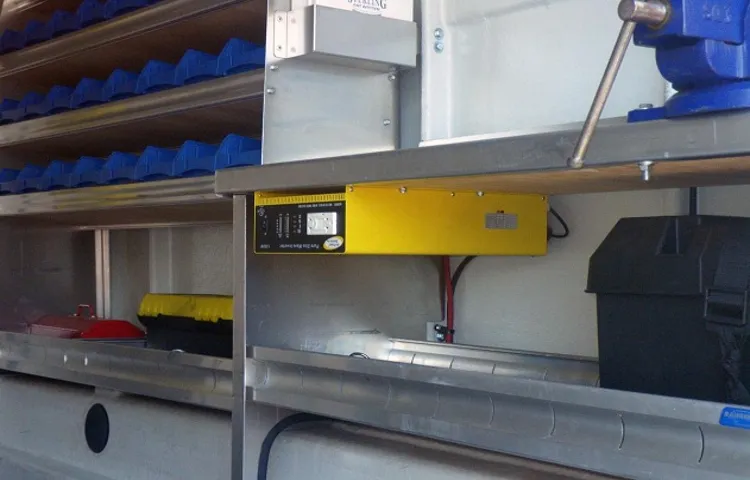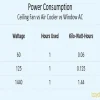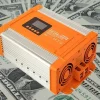Hey there, power enthusiasts! Are you ready to dive into the fascinating world of power inverters? If you’ve ever wondered how you can transform the DC power from your car or battery into AC power that can be used to charge your devices or run household appliances, then you’re in the right place. Power inverters have become an essential tool for anyone looking to harness the power of electricity wherever they go. Imagine this: you’re on a camping trip, surrounded by nature’s beauty.
But soon enough, you realize that you forgot to charge your phone, and you’re running out of battery. What do you do? Well, with the help of a power inverter, you can simply connect your phone charger to your car’s battery, and voila! Your phone is charging again, allowing you to capture and share those breathtaking moments. But power inverters aren’t just handy for outdoor adventures.
They also come in handy during power outages or when you’re on the road. With a power inverter in your car, you can power up your laptop, use a small fridge, or even watch your favorite movies on a portable DVD player. So how do power inverters work? Essentially, they take the DC (direct current) power from your car’s battery or an external battery and convert it into the AC (alternating current) power that your devices and appliances need.
This conversion process is done by an internal circuit called an inverter. Once the inverter does its magic, you can plug in your devices and enjoy the power they need to function. Now, you might be wondering about the different types of power inverters available.
Well, there are two main types: modified sine wave inverters and pure sine wave inverters. Modified sine wave inverters are more affordable and can handle most household appliances. On the other hand, pure sine wave inverters provide a smoother, cleaner power output that is ideal for sensitive electronics like laptops or medical devices.
As you can see, power inverters are versatile and powerful machines that offer a world of possibilities. Whether you’re an outdoor enthusiast, a frequent traveler, or just someone who wants to be prepared for power outages, having a power inverter by your side can make all the difference. So buckle up and get ready to explore the exciting world of power inverters in this blog series!
Table of Contents
What is a Power Inverter?
Have you ever wondered how much power an inverter can supply? Well, the answer to that question depends on the specific model and size of the power inverter. Inverters are devices that convert DC (direct current) power into AC (alternating current) power, allowing you to use electronic devices that require AC power when you are on the go or in areas where there is no access to a power grid. The power output of an inverter is typically measured in watts, and it can range from a few hundred watts for smaller inverters to several thousand watts for larger ones.
When choosing an inverter, it is important to consider the power requirements of the devices you plan to use with it. For example, if you want to power a laptop that requires 60 watts and a smartphone that requires 10 watts, you would need an inverter with a minimum power output of 70 watts. It is also important to note that the power output of an inverter may vary depending on factors such as the condition of the input battery and the efficiency of the inverter itself.
Therefore, it is always a good idea to choose an inverter with a slightly higher power output than you think you will need to ensure that it can adequately power your devices.
Understanding Power Inverter Capacity
Have you ever wondered how much power an inverter can supply? Well, it all depends on the capacity of the inverter. The capacity of a power inverter is usually measured in watts and determines the maximum load it can handle. It’s like the gas tank of a car – the bigger the tank, the more fuel it can hold.
Similarly, the higher the capacity of an inverter, the more power it can supply. So, if you have a high-capacity inverter, you’ll be able to power more devices at the same time. On the other hand, if you have a low-capacity inverter, you’ll need to be more careful about the number and type of devices you connect to it.
So, before purchasing an inverter, make sure to check its capacity to ensure it can handle your power needs effectively.

Importance of Power Inverter Capacity
power inverter, capacity, understanding, importance Are you interested in using a power inverter but unsure about its capacity? Understanding the capacity of a power inverter is crucial to ensure it meets your electrical needs. The capacity of a power inverter refers to its ability to convert DC (direct current) power from a battery into AC (alternating current) power that can be used to run various electronic devices. It is important to choose an inverter with the right capacity to prevent overloading or underutilization.
Similar to a water tank, a power inverter’s capacity determines how much power it can store and deliver. Just like a small tank may not be enough to meet your water needs, an underpowered inverter may not be able to handle the electrical demands of your devices. On the other hand, an overpowered inverter may be more expensive and unnecessary for your needs.
Therefore, understanding the capacity of a power inverter is essential for efficient and reliable power conversion.
Factors Affecting Power Inverter Capacity
power inverter capacity, factors affecting power inverter capacity, understanding power inverter capacity Power inverter capacity refers to the amount of power that a power inverter can deliver. It is an important consideration when choosing a power inverter for your needs. There are several factors that can affect the capacity of a power inverter, and understanding these factors is crucial to ensure that you choose the right inverter for your specific requirements.
One of the main factors that affects power inverter capacity is the voltage of the power source. Power inverters convert DC (direct current) power from a battery or solar panel into AC (alternating current) power that can be used to run household appliances and other devices. The voltage of the power source determines the output voltage of the inverter.
Therefore, it is important to choose an inverter with a capacity that matches the voltage of your power source. Another factor that affects power inverter capacity is the power demand of the devices or appliances that you want to run. Different appliances have different power requirements, and it is important to choose an inverter that can handle the maximum power demand of the devices you want to run simultaneously.
It is recommended to calculate the total power consumption of all the devices you want to run and choose an inverter with a capacity that is higher than the total power demand. The efficiency of the power inverter also affects its capacity. Inverters with higher efficiency can convert more DC power into AC power, resulting in a higher capacity.
Therefore, it is important to choose an inverter with a high efficiency rating to ensure that you get the maximum power output. The temperature also affects the capacity of a power inverter. High temperatures can reduce the efficiency of the inverter and therefore decrease its capacity.
It is important to install the inverter in a well-ventilated area and avoid exposing it to extreme temperatures. In conclusion, understanding the factors that affect power inverter capacity is crucial when choosing the right inverter for your needs. Factors such as the voltage of the power source, the power demand of the devices, the efficiency of the inverter, and the temperature all play a role in determining the capacity of a power inverter.
Calculating Power Inverter Capacity
Have you ever wondered how much power an inverter can supply? Well, the capacity of a power inverter is determined by its wattage rating. The wattage rating indicates the amount of power the inverter can deliver at a given time. When choosing an inverter, it’s important to consider your power needs.
For example, if you plan on using the inverter to power small electronic devices like laptops or smartphones, a lower wattage rating may be sufficient. However, if you need to power larger appliances like refrigerators or power tools, you will need an inverter with a higher wattage rating. It’s always a good idea to calculate your power requirements before purchasing an inverter to ensure that it can meet your needs.
So, whether you’re camping in the great outdoors or experiencing a power outage at home, knowing the power capacity of your inverter is crucial in ensuring that you have the power you need when you need it.
Step 1: Determine the Total Power Consumption
power inverter capacity
Step 2: Consider the Efficiency of the Power Inverter
calculating power inverter capacity When considering the efficiency of a power inverter, it is important to calculate its capacity accurately. The capacity of a power inverter is measured in watts and refers to its ability to handle the electrical load it is connected to. To calculate the power inverter capacity, you need to determine the total wattage of the devices you plan to connect to it.
Start by making a list of all the devices you intend to power with the inverter. Include their power ratings in watts, which are usually indicated on the devices or in their user manuals. Add up the wattage of all the devices on your list to get the total wattage.
This will give you an idea of the minimum capacity you should look for in a power inverter. However, it is important to consider some safety margin as well. It is recommended to choose a power inverter with a capacity that is at least 20-30% higher than the total wattage of your devices.
This extra capacity will ensure that the inverter does not become overloaded and can handle any power surges or fluctuations. So, when calculating the capacity of a power inverter, always consider the total wattage of your devices plus a safety margin to ensure efficient and reliable power conversion.
Step 3: Account for Peak/Surge Power Needs
As we continue our journey to calculate the power inverter capacity needed for our solar power system, it’s important to account for peak power needs or power surges. These are temporary increases in power consumption that occur when certain appliances or devices are turned on or when there is a sudden increase in energy demand. To ensure that our power inverter can handle these peak power needs, we need to calculate the surge power capacity.
Surge power is typically higher than the continuous power rating of the inverter and refers to the extra power required to start up appliances or devices. It’s like the burst of energy needed to get a car moving from a standstill, before settling into a steady driving speed. By accounting for peak power needs, we ensure that our power inverter is capable of meeting our power demands even during these temporary periods of high energy consumption.
So let’s dive in and calculate the surge power capacity for our solar power system.
Step 4: Check the Continuous Power Output of the Inverter
calculating power inverter capacity When it comes to choosing an inverter for your power needs, it’s important to understand how to calculate its capacity. The continuous power output of an inverter is a crucial factor to consider. This refers to the amount of power the inverter can consistently provide over a sustained period of time.
This is different from the peak or surge power, which is the temporary power output the inverter can handle during startup or when there is a sudden surge in power demand. To calculate the power inverter capacity, you need to consider two factors: the power rating of the appliances or devices you plan to run on the inverter, and the efficiency of the inverter itself. The power rating of your appliances can usually be found on their labels or specifications.
Add up the power ratings of all the appliances you want to run simultaneously. Next, consider the efficiency of the inverter. Inverters are not 100% efficient, meaning some power is lost during the conversion process from DC to AC.
Inverters typically have an efficiency rating, which is expressed as a percentage. To calculate the inverter capacity, divide the total power of your appliances by the efficiency of the inverter. For example, if you have a total power requirement of 2000 watts and your inverter has an efficiency rating of 90%, your required inverter capacity would be 2000 watts divided by 0.
9, which equals 2222 watts. In this case, you would need an inverter with a continuous power output of at least 2222 watts. It’s important to note that if your appliances have motors or other devices that require a large amount of power during startup, you may need to consider the peak or surge power capacity of the inverter as well.
This ensures that the inverter can handle the initial power demand without tripping or overloading. By calculating the power inverter capacity accurately, you can ensure that you have the right inverter for your power needs. This will prevent issues such as underpowered inverters that cannot handle your appliances’ power demands or overpowered inverters that are unnecessary and can result in wasted energy.
Common Power Inverter Sizes
When it comes to power inverters, one of the most common questions is how much power can they supply. Well, the answer to that depends on the size of the inverter. Power inverters come in a variety of sizes, measured in watts.
The larger the inverter, the more power it can supply. For example, a small inverter might be around 300 watts, which would be suitable for powering small electronics like laptops or cell phones. On the other end of the spectrum, a large inverter could be as high as 5000 watts or more, capable of powering appliances like refrigerators or power tools.
So, it’s important to consider what devices you will be using with your inverter and choose a size that can handle the power requirements.
Choosing the Right Power Inverter for Your Needs
When it comes to choosing the right power inverter for your needs, one of the most important considerations is how much power it can supply. The power output of an inverter is typically measured in watts, and it determines the types and number of devices that can be connected to the inverter. Before making a purchase, it’s crucial to determine how much power you will need.
Start by making a list of all the devices you plan to power with the inverter and note down their power requirements in watts. Add up the power requirements and choose an inverter that can supply at least that amount. It’s always a good idea to leave some extra headroom to account for any future power needs or unexpected surges in power usage.
So, when selecting an inverter, be sure to consider how much power it can supply to ensure it meets your needs.
Identify the Load Requirements
power inverter, load requirements, choosing the right power inverter
Consider the Battery Capacity
power inverter, battery capacity, choosing the right power inverter, power needs, power requirements, electrical devices, car battery, portable devices, appliances, power backup, energy-efficient, long-lasting power, electrical system, Choosing the right power inverter for your needs is crucial to ensure that you have enough power to run all your electrical devices. One important factor to consider is the battery capacity. The battery capacity determines how much power the inverter can provide and for how long.
If you have a car battery, for example, you may not have the capacity to run large appliances or power backup for an extended period. On the other hand, if you have a portable power station with a higher battery capacity, you can power more appliances and have a longer-lasting power supply. It’s important to assess your power requirements and choose a power inverter that matches your needs.
This way, you can ensure that you have enough energy-efficient, long-lasting power for all your devices, without overloading your electrical system. So, when choosing a power inverter, don’t forget to consider the battery capacity to make the right choice.
Calculate the Necessary Inverter Size
When it comes to choosing the right power inverter for your needs, one of the most important factors to consider is the size of the inverter. The size of the inverter refers to the amount of power it can handle, and it is essential to choose the right size to ensure that it can meet your energy requirements. To calculate the necessary inverter size, you need to consider the total wattage of the appliances or devices you plan to power with the inverter.
Add up the wattage of each device and make sure the inverter you choose can handle the total load. It’s also important to consider any power surges or bursts that may occur, as some devices require more power when they first start up. By accounting for these factors, you can ensure that you choose an inverter that is the right size for your needs and will provide reliable power when you need it.
Conclusion
In conclusion, the power of an inverter knows no bounds, much like a magician with an endlessly deep top hat. It has the ability to harness the mystical energy of DC and transform it into the electrifying power of AC. Whether you need a gentle trickle of power to charge your phone or a formidable surge to bring your kitchen appliances to life, the inverter has your back.
It’s like having a wizard in your pocket, granting you the power to defy the limitations of electricity and bring convenience to every corner of your life. So let your imagination run wild, for with an inverter by your side, the possibilities are as limitless as the vast expanse of the universe itself.”
FAQs
How much power can an inverter supply?
The power output of an inverter can vary depending on its capacity, but typically, inverters can supply power ranging from a few hundred watts to several kilowatts. The exact power capacity of an inverter should be specified by the manufacturer.
What factors determine the power capacity of an inverter?
The power capacity of an inverter is influenced by various factors, including the size and quality of its internal components, the input voltage and frequency range it can handle, and the efficiency of its conversion process. Additionally, the chosen application or load requirements will also impact the power capacity needed.
Can an inverter supply different power levels simultaneously?
Inverters are typically designed to supply a consistent power level, either continuously or for a specific duration. While some advanced inverters might allow for load prioritization or power sharing between outlets, they typically don’t supply multiple power levels simultaneously.
Is the power output of an inverter constant?
The power output of an inverter can vary depending on the load connected to it. However, inverters should be able to maintain a relatively stable power output within their specified capacity, as long as the connected load doesn’t exceed that capacity.
How does the input voltage affect the power capacity of an inverter?
The input voltage range that an inverter can handle determines its power capacity. If the input voltage exceeds the specified range, the inverter might not be able to supply the full power output or may shut down to protect itself from damage.
Can inverters provide power to all types of electrical devices?
Inverters can generally power a wide range of electrical devices, including household appliances, electronics, and power tools. However, some devices with high starting currents or sensitive electronics might require inverters with special features, such as surge capacity or pure sine wave output.
Are there limits to the continuous power output of an inverter?
Yes, inverters have continuous power ratings specified by the manufacturer. Exceeding the continuous power output for an extended period can overheat the inverter and potentially cause damage. It is important to choose an inverter with sufficient continuous power capacity for the intended load.



